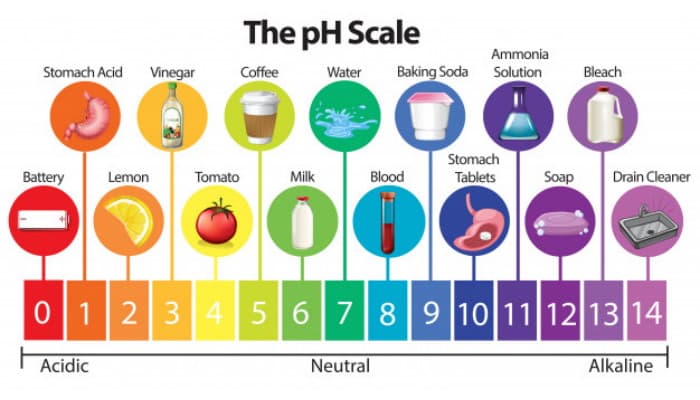 Cibo vettore creata da brgfx - it.freepik.com
Cibo vettore creata da brgfx - it.freepik.comThe expression acid-base balance, in biology, indicates the whole of the physiological processes that the organism puts in place to maintain within it a level of acidity compatible with the conduct of the main metabolic functions. Thanks to these processes, the PH of blood is normally maintained on values between 7.35 and 7.45.
A healthy organism presents organic homeostasis. This balance is not static, but highly dynamic: it can vary depending on the presence of pathologies, trauma, stress (both physical and mental), according to the way we feed (the macros are fundamental but do not forget quality and timing). If we are in perfect health, our body is perfectly able to react to all these different stimuli to maintain homeostasis but, in case our body is less efficient (due to a decrease in the immune system, seasonal diseases Due to viral or bacterial infections or autoimmune diseases, chronic inflammation) One can establish what is defined as metabolic acidosis.
Causes metabolic acidosis
There are many factors that can lead to a condition of metabolic acidosis:
- Insufficient nutrient intake alkalizing
- Excess of Acidifier Foods
- Insufficient intake of liquids
- Medicines
- Stress
Symptoms metabolic acidosis
The symptoms are quite similar to those of chronic inflammation: chronic fatigue, foggy mind, muscle cramps, water retention, glaring dark circles, dehydration, increased sensitivity to pain. If this condition lasts over time it can lead to unpleasant and varied consequences, from bone demineralization to early ageing (imbalance between free radicals and antioxidants) to muscle catabolism in athletes.
Metabolic acidosis is nothing more than a accumulation of metabolic slag from intense physical activity, exposure to environmental pollutants, chronic use of drugs, poor intake of liquids, sedentary, incorrect choice of foods, consumption Frequent smoke and alcohol.
Possible Test and metabolic acidosis remedies
The diet plays an important role in the management of acid-base balance. Every food, in fact, depending on its composition, can provide the body with an acid load or can provide substances that neutralize these acidic slag.
The terminal products of metabolism are mainly acidic and our body tries to eliminate them through the excretory organs (liver, kidneys, lungs, skin, intestine).
The fluctuations of the physiological pH depend on a part from the metabolic processes that can produce organic acids (lactic acid, ß-hydroxybutyric acid, acetoacetic acid, etc) and inorganic acids (carbonic acid, dihydrogen ion), and on the other Part of the PH changes depend on the power supply that can introduce alkaline salts of Na +, K +, Ca + + and Mg + +.
The best way to verify and make sure of this condition is the analysis of the urine thanks to an analysis laboratory or with the use of tampons available in pharmacies: The ideal value is the range 6.5-7.5 . If the values of the urinary PH are repeatedly acidic (a momentarily acid value is more than normal) and deviate considerably from the ideal curve, you need to change your lifestyle, increase the intake of foods alkalizing and possibly supplement the supply with specific products based on mineral salts alkalizing (mainly potassium, magnesium, calcium and phosphorus; As regards chlorine, phosphorus and zinc instead tend to be Acidifiers).

What are these alkalizing foods?
Have you ever heard of the index PRAL ( Potential Renal Acid Load )?
PRAL is a valid method proposed by Remer and beef, used to calculate the chemical balance of the acidifier and alkalizing molecules of a food or a supplement. It does not merely establish the ph of a compound but estimates its ability to interact with human blood (of the ph-compatible range of life: 7.38-7.42).
In Layman's words, we can say that the PRAL determines the acid-base effect of a compound on the human body.
For estimation, PRAL takes into account the variables of total proteins, sulphur of the amino acids sulfur, phosphorus (P), potassium (K), magnesium (Mg), calcium (Ca).
CAUTION!!
It is not enough to simply consider the PRAL index of a single food, you have to observe the context, you have to evaluate the index of the whole meal (a bit like you do for the glycemic index) but still not enough...
It is necessary to consider how that single food has been processed: the more processed the more it will have acidifiing power. A practical example concerns fats: fats such as extra virgin olive oil, corn, sunflower, coconut have a rather neutral PRAL as well as animal fats (e.g. butter) because they are not treated, they are poorly processed. If, instead, we take into account the vegetable alternatives of butter (e.g. margarines) These are highly processed, rich in TRANS fatty acids that are harmful to health in general (from acid-based equilibrium to the cardiovascular system). Better than the consumption of good quality butter rather than these alternatives (if you are vegetarian or vegan better to eliminate these alternatives altogether).
In recent years we have witnessed the advent of the defined products of IV Gamma: They are packaged, clean, packed and ready to use products (also fruit and vegetables). Even if they are organic companies or otherwise reliable by virtue of things these products will tend to be acidifiers (despite fruits and vegetables are the same as alkalizing) because the packs, packaging and tissue paper are treated with Chlorine-based sterilizers before coming into contact with food.
Food & PRAL
Meat: All types of meat are of an acidifiing nature
Fish Especially tuna, swordfish, eel and shellfish rich in zinc
Cereals and Legumes : all legumes and foods based on carbohydrates (refined or integral) are acidifiers. There are, however, some types of cereal such as the millet, quinoa, amaranth, buckwheat with the lowest pral index
Sweets: They are all acidifiers since they contain sugar (refined or cane makes no difference), refined fats and flours. The only exceptions relate to bitter cocoa powder and dark chocolate (> 85%, the higher the quantity of "cocoa mass" the less the Acidifiing effect)
Dried fruit: pumpkin seeds, flax and sunflower, peanuts and sesame tend to be acidifier
They are alkalizing almonds, walnuts and hazelnuts, flax seeds and chia
seeds.
Fatty: All fats, animals or vegetables, are more or less neutral
If the fat is refined, fried or processed (vegetable margarines for example) the acidity values rise (better than the butter as the ghee rather than margarines, not only for the Pral index but also for the metabolic flexibility and cardiovascular health)
Eggs, milk and dairy products: eggs, milk and cheeses are strongly acidifiing
The white yogurt (both skinny and whole) and ricotta are slightly alkalizing
Beverages: Spirits, packaged juices and carbonated beverages are acidifier
Coffee and tea are medium-acidified, (the coffee beans of good quality is slightly alkaline, as well as the tea used in leaves rather than sachets) the only brand of te and herbal teas in reliable filters is Yogi Tea: The grinding of the grains and the chopping of Leaves increases acidity. Better then prefer whole leaf infusions and not by sachet
Almond milk without sugar is alkaline and can be safely used
Spices: Especially recommended sage, rosemary, ginger, pepper, chili, turmeric, curry, fennel seeds, cumin seeds
Fruits and Vegetables: any kind of fruit or vegetable is alkaline and ' fundamental the seasonality to get a greater value alkalizing (if we find fruits and vegetables out of season, by virtue of things have been undergo some treatment).
Prefer fresh and local foods, not canned or products of IV range (i.e. in bust/packaged and ready to eat even if it is pre-packaged and ready-made fruits and vegetables).
It is also important to cook: prefer sweet cooking that does not lead to a loss of minerals from vegetables (steaming, scalding, raw vegetables, vegetable carpaccio).
Finally, very useful to counteract the acidosis, are some "food-supplements" such as Chlorella and spirulina.
In particular the Chlorella: the Queen of Detox.
It is a unicellular micro-alga that contains the largest chlorophyll resource of all plants. Chlorophyll has a unique affinity with oxygen similarly to hemoglobin, helps:
- Clean, moisturize and oxygenate blood
- Aggregate and expel heavy metals and pesticides from the
organism
- Alkalize the Body
- Clean the vital organs like the intestines
- Increase the number of red blood cells
- Restore
- Stimulating the immune system
Simple Recommendations
In the end the general rules are:
- Follow the seasonality of Foods
- Always choose fresh food and have been processed as little as possible
- Next to a protein dish never miss a good dose of fruit or vegetable
- Pay due attention to the mineral salts taken (with diet and/or integration) and the quality of the water that is introduced
- Learn to listen to your body: As always there are general rules and guidelines but then you have to model them according to your needs.
Curated by
Dott.ssa Patalano Myriam Biologist Nutritionist
Ischia Nutrizione Patalano
